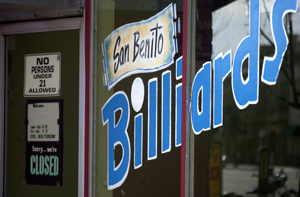Public still has chance to voice its opinion on signs around
town
The Hollister city sign ordinance hasn’t been updated since the
1970s, but city staff is working with planning commissioners, city
council members and the public to update the laws.
Public still has chance to voice its opinion on signs around town
The Hollister city sign ordinance hasn’t been updated since the 1970s, but city staff is working with planning commissioners, city council members and the public to update the laws.
“It’s all part of our update for the entire zoning code,” said Abraham Prado, an assistant planner with the city. “We are updating it to apply to the general plan that was adopted in 2005.”
The staff planned to present the most recent draft of the sign ordinance at the Feb. 28 planning commission meeting, after the Pinnacle press deadline. The most recent draft has been updated to include some directions commissioners gave to planning staff at a January meeting.
The original ordinance outlawed the use of sandwich board signs – A-frame signs that are generally not attached to a building or walkway that display information on each side. Some A-frame signs can be seen around downtown Hollister listing daily specials outside of restaurants or in residential areas to alert people to open houses.
“We recommended they not be allowed in a public right of way,” said Mary Paxton, the planning manager. “We were concerned about making sure there is ample access for all types of pedestrian travel.”
The draft from January allowed for two A-frame signs for open houses, but the commissioners asked for more flexibility for open house signs. The new draft ordinance allows for eight open house A-frame signs.
“They wanted an allowance for open houses and more flexibility for size and height of free-standing signs,” Paxton said.
Other issues addressed in the draft include more flexibility for signage in commercial centers. Currently the footage for free-standing signs is a total of 50 square feet, with a maximum height of 20 feet. With the addition of larger commercial centers, such as the proposed Lowe’s development along the Hwy. 25 bypass, city officials called for larger signs that would attract motorists.
Part of the ordinance will also allow for new gateway signage that will notify travelers when they enter Hollister city limits and alert them to nearby destinations. Staff members have planned for gateway signs along Hwy. 156 into town and Hwy. 25.
“Part of the intent is for pedestrians or motorists to easily identify the addresses of a commercial center,” Paxton said. “In downtown what they probably want is more flexibility for pedestrian-oriented signs in downtown since it is a mixed-use designation.”
One way some cities have dealt with downtown area signage is to use what are referred to as blade signs. These are signs that come out from the building façade and are perpendicular with the street so that pedestrians can easily read them as they walk by. In Dublin, a city that has a sign ordinance complete with pictoral examples of do’s and don’ts, blade signs must have a clearance of at least 8 feet and can be a maximum of 4 feet wide. The city allows a maximum amount of sign space so businesses can combine different types of signage, be it blade signs, walls signs or others.
Blade signs are especially popular in tourist cities such as Carmel and Santa Barbara, where people are likely to park in one location and browse through shops and restaurants. The Hollister ordinance created in the 1970s does not address signs of this type.
One of the big considerations in deciding on what types of signs will be allowed is safety, “making sure it doesn’t obstruct vision for motorists or pedestrians,” Paxton said.
In other cities, there are very clear definitions of what types of signs are allowed and which are not. For instance, window signs that cover more than 25 percent of an individual window’s area are outlawed in Dublin. They can be a safety hazard for police officers responding to calls. Other signs that are outlawed include signs attached to fences, inflatable or moving signs, and handheld signs, as they can obstruct pedestrians or motorists.
In Hollister flashing signs, moving signs, pennants and streamers, as well as others are illegal. Though the code enforcement officer does issue fines for signs that are out of compliance, he does not patrol looking for them.
“The code enforcement is generally driven by complaint,” Paxton said.
To view the most recent draft of the sign ordinance, residents may get a copy online at hollister.ca.gov by clicking on the Planning department page. They may also view a copy in the office, 420 Park Hill, Bldg. A. For more information, call 636-4360.










